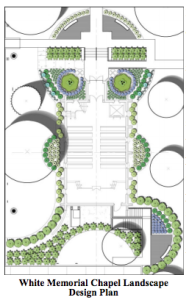 In Utah’s dry climate, water wise landscape architecture is key for commercial properties seeking to save money while maintaining an attractive design. But landscape architecture can also be a critical component of the redesign and upkeep of landmark properties on which historic landmark buildings sit. Good landscape architecture can be used to update the site and save money, while keeping the beauty and character of the original building.
In Utah’s dry climate, water wise landscape architecture is key for commercial properties seeking to save money while maintaining an attractive design. But landscape architecture can also be a critical component of the redesign and upkeep of landmark properties on which historic landmark buildings sit. Good landscape architecture can be used to update the site and save money, while keeping the beauty and character of the original building.
Case in point: this year the McNeil team was commissioned by the State of Utah Division of Facilities Construction & Management (DFCM) to provide the landscape architecture for the grounds update at the historic White Memorial Chapel in Salt Lake City. The idea was to redesign the grounds to both beautify and save money, and do it in a way that was in keeping with the historic architecture that is the focal point of the landmark.
Are you familiar with this historic Salt Lake City building? The White Memorial Chapel is a reproduction that has original elements incorporated. The original building was designed in the Gothic revival style in the early 1880′s, with a steeple and stained glass windows. Those elements, along with the doors, pulpits and benches have been preserved in the reproduction erected on the same site near the Utah State Capitol in the 1980′s.
The building is eye catching, and often used for weddings. Due to the unique character of the building and its history in the community, state leaders wanted landscaping that would complement the unique gothic architecture and preserve the picturesque beauty of the setting — all while saving money and water.
So, how do we accomplish such a task? In general, we have some best practices we use on each project.
Good choices for water-wise landscape architecture
First, it’s important to consider what types of plants are desired. Options for drought tolerant landscaping can include the use of small flower beds and ornamental, drought resistant grasses. In other cases, based on the overall design of the building, it may be more appropriate to go with cacti or yucca. The choice of plants is a critical factor, but it’s not the only consideration.
We can also create irrigation and water retention systems to save water and promote efficiency if more traditional plants are desired.
Water-wise landscape architecture may also include what we can “hardscaping.” Ornamental design can include things like stone structure, rocks and gravel designed to be attractive but not use any water whatsoever. The use of ornamental walkways, art installations, and sculptures are other attractive and practical options.
Landscape architecture used at White Memorial Chapel
So, how were those best practices incorporated in the White Chapel project? The McNeil Engineering Landscape Architecture & Site Design Team, lead by Scott Schoonover, made a few key decisions to meet the goals of the project.
They designed a symmetrical landscape with attractive concrete walkways and seating areas to complement the gothic architecture and encourage visitors to stop and enjoy the view. They added an irrigation system with remote rain and freeze sensors, to help save on water, time and money.
Included in the design are also water-wise planter bed with drip system, and incorporated drought-tolerant xeric plants and species that are visually pleasing and ecologically friendly.
In fact, in all of our projects we utilize the latest software and computer-aided technologies for design, project management and cost control. With integrated simulations, 3-D imaging, mapping, CAD and Geographic Information Systems, we can illustrate for our client’s precise visual representations of a plan and project features allowing for better cost, scheduling and design decisions.
With over 35 years of experience the McNeil Engineering team provides the landscape architecture and engineering services organizations can trust. If you’d like to know more, visit us online or give us a call.








